Multiple integrations of human foamy virus in persistently infected human erythroleukemia cells
- PMID: 10644342
- PMCID: PMC111647
- DOI: 10.1128/jvi.74.4.1718-1726.2000
Multiple integrations of human foamy virus in persistently infected human erythroleukemia cells
Abstract
Foamy viruses are complex retroviruses whose replication strategy resembles that of conventional retroviruses. However, foamy virus replication also resembles that of hepadnaviruses in many respects. Because hepadnaviruses replicate in an integrase-independent manner, we were interested in investigating the characteristics of human foamy virus (HFV) integration. We have shown that HFV requires a functional integrase protein for infectivity. Our analyses have revealed that in single-cell clones derived from HFV-infected erythroleukemia-derived cells (H92), there were up to 20 proviral copies per host cell genome as determined by Southern blot and fluorescent in situ hybridization analysis. Use of specific probes has also shown that a majority of the proviruses contain the complete tas gene, which encodes the viral transactivator, and are not derived from Deltatas cDNAs, which have been shown to arise rapidly in infected cells. To demonstrate that the multiple proviral sequences are due to integration instead of recombination, we have sequenced the junctions between the proviral sequences and the host genome and found that the proviruses have authentic long terminal repeat ends and that each integration is at a different chromosomal site. A virus lacking the Gag nuclear localization signal accumulates fewer proviruses, suggesting that nuclear translocation is important for high proviral load. Since persistently infected H92 clones are not resistant to superinfection, the relative importance of an intracellular versus extracellular mechanism in proviral acquisition has yet to be determined.
Figures
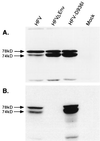
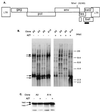

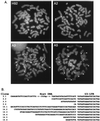
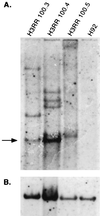

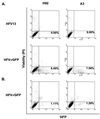
Similar articles
-
An active foamy virus integrase is required for virus replication.J Gen Virol. 1999 Jun;80 ( Pt 6):1445-1452. doi: 10.1099/0022-1317-80-6-1445. J Gen Virol. 1999. PMID: 10374962
-
Infectious proviral clones of chimpanzee foamy virus (SFVcpz) generated by long PCR reveal close functional relatedness to human foamy virus.Virology. 1995 Dec 20;214(2):685-9. doi: 10.1006/viro.1995.0086. Virology. 1995. PMID: 8553577
-
Study of human foamy virus proviral integration in chronically infected murine cells.Res Virol. 1998 Nov-Dec;149(6):393-401. doi: 10.1016/s0923-2516(99)80007-7. Res Virol. 1998. PMID: 9923015
-
Particle assembly and genome packaging.Curr Top Microbiol Immunol. 2003;277:89-110. doi: 10.1007/978-3-642-55701-9_4. Curr Top Microbiol Immunol. 2003. PMID: 12908769 Review.
-
Foamy viruses.Intervirology. 1993;35(1-4):196-207. doi: 10.1159/000150310. Intervirology. 1993. PMID: 8407246 Review.
Cited by
-
Nonintegrating foamy virus vectors.J Virol. 2010 Sep;84(18):9341-9. doi: 10.1128/JVI.00394-10. Epub 2010 Jun 30. J Virol. 2010. PMID: 20592072 Free PMC article.
-
A novel function for spumaretrovirus integrase: an early requirement for integrase-mediated cleavage of 2 LTR circles.Retrovirology. 2005 May 18;2:31. doi: 10.1186/1742-4690-2-31. Retrovirology. 2005. PMID: 15904533 Free PMC article.
-
Role of the foamy virus Pol cleavage site in viral replication.J Virol. 2007 May;81(10):4956-62. doi: 10.1128/JVI.00104-07. Epub 2007 Mar 7. J Virol. 2007. PMID: 17344283 Free PMC article.
-
Foamy virus integration.J Virol. 2004 Mar;78(5):2472-7. doi: 10.1128/jvi.78.5.2472-2477.2004. J Virol. 2004. PMID: 14963145 Free PMC article.
-
Cell-type-specific regulation of the two foamy virus promoters.J Virol. 2001 Jul;75(14):6547-57. doi: 10.1128/JVI.75.14.6547-6557.2001. J Virol. 2001. PMID: 11413322 Free PMC article.
References
-
- Achong B G, Mansell P W A, Epstein M A, Clifford P. An unusual virus in cultures from a human nasopharyngeal carcinoma. J Natl Cancer Inst. 1971;46:299–307. - PubMed
-
- Ausubel F M, Brent R, Kingston R E, Moore D D, Seidman J G, Smith J A, Struhl K, editors. Current protocols in molecular biology. Vol. 1. New York, N.Y: John Wiley & Sons, Inc.; 1998.
-
- Birren B W, Tachi-iri Y, Kim U J, Nguyen M, Shizuya H, Korenberg J R, Simon M I. A human chromosome 22 fosmid resource: mapping and analysis of 96 clones. Genomics. 1996;34:97–106. - PubMed
-
- Bock C T, Schwinn S, Schroder C H, Velhagen I, Zentgraf H. Localization of hepatitis B virus core protein and viral DNA at the nuclear membrane. Virus Genes. 1996;12:53–63. - PubMed
Publication types
MeSH terms
Substances
Grants and funding
LinkOut - more resources
Full Text Sources
Other Literature Sources

